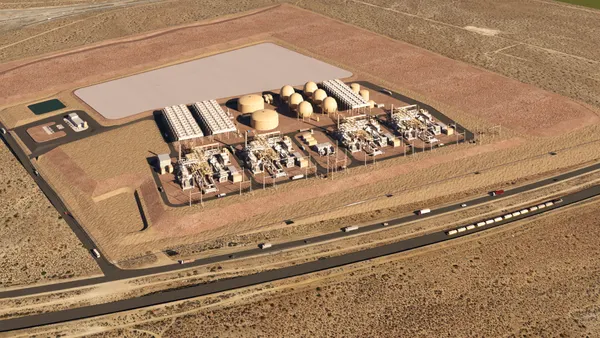Dive Brief:
- Governments and utilities need to rethink the way they evaluate long-duration energy storage projects to make them more economical, officials from the Department of Energy (DOE) and energy storage companies said at a panel on Wednesday.
- Javier Cavada, CEO of London-based storage company Highview Power, said that because long-duration storage absorbs power that would not otherwise be used and then distributes it later, it should be compared to other generating sources. Modeling solar and wind projects with long-duration storage, he said, would show a "way, way, way lower cost and way, way more value" than a fossil fuel asset.
- Max Tuttman, the technology-to-market adviser for DOE's Advanced Research Projects Agency–Energy (ARPA-E) program, also said the value of long-duration assets can't be seen purely through an energy metric. "These are fundamentally, in a way, capacity assets," Tuttman said on the panel hosted by intersolar North America and Energy Storage North America.
Dive Insight:
Long-duration energy storage, which can store energy for at least 10 hours, is seen as a crucial asset for the grid amid a transition to renewable energy. The storage can mitigate the day-to-day and seasonal variability of wind and solar, providing power when the sun is not shining or the wind is not blowing.
However, the high up-front cost and comparatively high cost of power compared to nuclear and natural gas plants has limited the growth of new long-duration projects on the grid. Debbie Mursch, director of business development for hydro at GE Renewable Energy, said that reflects skewed markets and policies from governments and grid operators that do not recognize the full value of storage.
"[Power purchase agreements] in our country are short-term, they're looking five years out and are still geared towards batteries," Mursch said. "I believe the U.S. needs a plan … a complete, integrated plan that is long term and considering grid instability."
Mursch's team is working on pumped-storage hydropower, a well-established storage technique that uses two reservoirs of water to store energy which is then generated by powering a turbine. According to DOE, pumped hydro represents the vast majority of long-duration storage in the U.S.
Highview Power, meanwhile, is developing a compressed air system that stores power by compressing air as a liquid, then returning it to a gas to power a turbine. There is a wide suite of other technologies available, including pumped thermal storage and other chemical carriers.
The variety of technologies available, the panelists said, also shows how long-duration storage can be adapted to work in different markets, including in existing infrastructure. Those advantages — compared to fossil fuel plants — should make long-duration storage more competitive to investors, Cavada said.
In a separate panel Thursday, executives from multiple utilities likewise said that they are seeking out a variety of technologies for long-duration storage. Fouad Dagher, director of customer innovation for National Grid in Massachusetts, said his utility takes a tech-neutral approach to its requests for storage "as long as it meets the goal of safety and reliability."
DOE announced an initiative this week to drop the cost of long-duration storage by 90% in a decade, which administration officials said would make the projects more economical and efficient as part of the push to a 100% clean power grid by 2035. The Earthshot Initiative will include research and development funding and large-scale demonstration projects.
The utility executives speaking Thursday also agreed that regulators should set more consistent rules governing storage. While grid operators are still determining how to integrate storage into the marketplace, the lack of consistency can create "barriers to deployment," said Lindsay Saxby, director of power resources for California-based community choice aggregation program MCE. Saxby said that changing California Independent System Operator rules made it difficult to properly value storage, especially considering the technology's broader benefits.
DOE's Tuttman said that in a changing electricity marketplace, storage developers have a key role to play in making sure the assets are treated properly.
"I advocate that tech developers … try to educate the market on how to value this product," Tuttman said. "Go out and find customers whose problems you can solve with your technology sooner rather than later … There are customers out there who can extract value from this technology now."
Correction; An earlier version of this article inadvertently conflated two quotes by Max Tuttman. The story has been updated with the correct quote.













